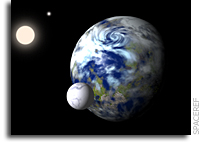Dynamics and Habitability in Binary Star Systems

Determining planetary habitability is a complex matter, as the interplay between a planet’s physical and atmospheric properties with stellar insolation has to be studied in a self consistent manner.
Standardized atmospheric models for Earth-like planets exist and are commonly accepted as a reference for estimates of Habitable Zones. In order to define Habitable Zone boundaries, circular orbital configurations around main sequence stars are generally assumed. In gravitationally interacting multibody systems, such as double stars, however, planetary orbits are forcibly becoming non circular with time. Especially in binary star systems even relatively small changes in a planet’s orbit can have a large impact on habitability.
Hence, we argue that a minimum model for calculating Habitable Zones in binary star systems has to include dynamical interactions.
Siegfried Eggl, Nikolaos Georgakarakos, Elke Pilat-Lohinger (Submitted on 2 Dec 2014)
Comments: accepted for publication
Subjects: Earth and Planetary Astrophysics (astro-ph.EP)
Cite as: arXiv:1412.1118 [astro-ph.EP] (or arXiv:1412.1118v1 [astro-ph.EP] for this version)
Submission history From: Siegfried Eggl [v1] Tue, 2 Dec 2014 22:08:36 GMT (6745kb,D)








